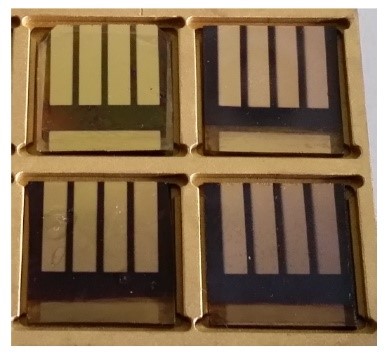Perovskite solar cells
The perovskite solar cell technology is the emerging star in photovoltaics. The first article published on a perovskite absorber by the research group of Nam-Gyu Park in 2011 followed an unprecedented rapid improvement in efficiency to more than 19% within less than three years. In 2016 researchers from KRICT and UNIST managed to reach a certified efficiency of over 22%.

These results were achieved with the organic-inorganic metal halide, methylammonium lead iodide (CH3NH3PbI3), which has a perovskite crystal structure, using solution-based thin-film deposition techniques. Perovskite thin films exhibit exceptional properties for solar cell applications such as high absorption, a suitable band gap, high charge carrier diffusion length and low recombination rate. Fig. 2 shows the classical material stack of a perovskite solar cell, in which the ETM is the electron transport material and the HTM is the hole transport material.
The optoelectronic material properties of the perovskites can be finely tuned for specific applications by exchanging the organic molecule, the metal, or the halide. For example, the energy band gap can be varied over a wide range, by varying the components. This allows their application in tandem cell devices, which could achieve a much higher efficiency than single junction solar cells.
The extraordinary potential of perovskite solar cells has been confirmed on lab scale. For the development of commercial, low-cost products however, key challenges such as long-term stability, the development of large-scale manufacturing processes and the replacement of lead with more environmentally friendly metals have to be tackled.
Our research:
Since 2013, our group has been developing perovskite solar cells to advance the technology of renewable energies. Since the electronic behavior of the devices is essentially determined by the chemical and electronic structure of the components at their interfaces, we employ photoelectron spectroscopy on step-wise deposited contact materials, whereby the contact properties such as the formation of interface states and contact potentials can be followed. The goal is the development of band diagrams over the entire solar cell. By varying the process parameters, the contact properties and thus the efficiency of the solar cells can be optimized.
Characterization techniques:
For the optimization of the solar cells, we use analytical methods which allow us to characterize them on a molecular level and determine characteristics of their components, such as:
• X-ray, ultraviolet and synchrotron radiation photoelectron spectroscopy
• Inverse photoelectron spectroscopy and energy loss spectroscopy
• Raman and UV/Vis spectroscopy
• X-Ray diffraction
• Scanning and transmission electron microscopy
• Quantum efficiency
• IV characteristics with a solar simulator
Our cooperation partners:
Our perovskite research takes place within the collaborative project PeroSol, whose speaker is Prof. Jaegermann, head of the Surface Science group in our institute. The PeroSol project is funded by the German Federal Ministry of Education and Research (BMBF).
Our partners are Prof. Himmel from the Department of Chemistry at the Heidelberg University and Prof. Lemmer from the of Light Technology Institute at the Karlsruhe Institute of Technology (KIT).
In addition, we are working on solar cells with inverted architecture within a DFG project in cooperation with Prof. Riedl from the Chair of Electronic Devices of BU Wuppertal.
Become part of our team:
• as HIWI
• within your Advance Research Lab
• writing your Bachelor thesis
• by writing your Master thesis
• as a guest scientist




